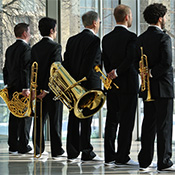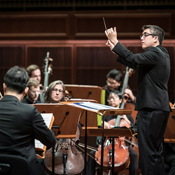
Canadian Brass Return to the Bradley Symphony Center
David Lewellen
PUBLISHED
Tagged Under: 2024.25 Season, Bradley Symphony Center
A few nights ago, the members of the Canadian Brass stepped off the elevator into the hotel lobby — and heard their own music playing over the sound system.
It was a classic moment for the world’s most famous brass group, which brings its holiday tour to the Bradley Symphony Center on Dec. 5.
“It’s an amazing privilege” to connect with audiences during the holiday season, said trumpeter Joe Burgstaller. “Twenty times a year, we do something that a person with a normal life might consider to be a once-in-a-lifetime experience. The tradeoff is that we work when other people are off.”
“It brings us joy, too, I will say,” added trumpeter Mikio Sasaki, the group’s newest member. Speaking from a hotel room in Portsmouth, Ohio, he said, “Even if it’s been a long day, we sit down and play, and no one’s thinking about that flight.”
At one recent concert on the Christmas tour, the group played the Vince Guaraldi version of “O Tannenbaum” made famous in “A Charlie Brown Christmas,” and Sasaki noticed a woman in the audience who was crying. “We brought something to her life, and it was a special moment to see that,” he said. “I’m already in the holiday spirit myself. I love the holiday tour.”
Over the course of 55 years, the Canadian Brass has become a musical and cultural landmark. Both Burgstaller and Sasaki grew up watching the group on PBS and listening to its CDs. Burgstaller recently rejoined the group after a hiatus to get married and start a family. (All of the members have teaching positions at various universities when they are not on the road.)
The quintet has seen considerable turnover, with only founding tubist Chuck Daellenbach as a constant. “The job takes creativity and a willingness to adapt,” Burgstaller said. Before the 1950s, almost no music was written for brass quintet, so members of the group have had to arrange much of their own repertoire.
Burgstaller, who does some of the group’s arrangements, says that when he listens to music, he is constantly thinking about what might sound good with the quintet. “I might think, ‘That would sound great on the horn,’ or ‘I can imagine Mickey playing that on the piccolo trumpet.’ Or tuba lines — Chuck is the greatest lyrical tubist I’ve ever heard.”
“We play different styles, but all of them in a very genuine way,” Sasaki said. “When we approach Mozart, we’re thinking like string players.”
One of the group’s trademarks is its wide range of styles, but they say they don’t deliberately leave a spot on the program for the jazz piece or the pop piece. “We discuss the program order at more length than I expected — usually over a meal,” Sasaki said. “We talk about the energy of each half, and how certain pieces are going to change the flow of the concert. The program is a living organism.”
Aside from being a great musician and colleague, an important qualification to be in the Canadian Brass is a sense of entrepreneurship — a topic that Burgstaller also teaches to his trumpet students at Arizona State University. “Every year is a brand new world in the music business,” he said. “And only a small part of it is institutions like an orchestra or military band, where the business is taken care of. Finding money and finding audiences are creative endeavors in their own right.”
The current online environment contains opportunities as well as challenges. “People have more access to music now than ever, more chances to come across a piece they end up loving,” Sasaki said.
But learning a piece from a recording still doesn’t compare to hearing it live, or to audiences and performers mingling after the concert. “The Canadian Brass was the first group to break down the wall,” Burgstaller said. “The audience becomes the sixth member of the group. There’s nothing like the live, in-person experience.”


